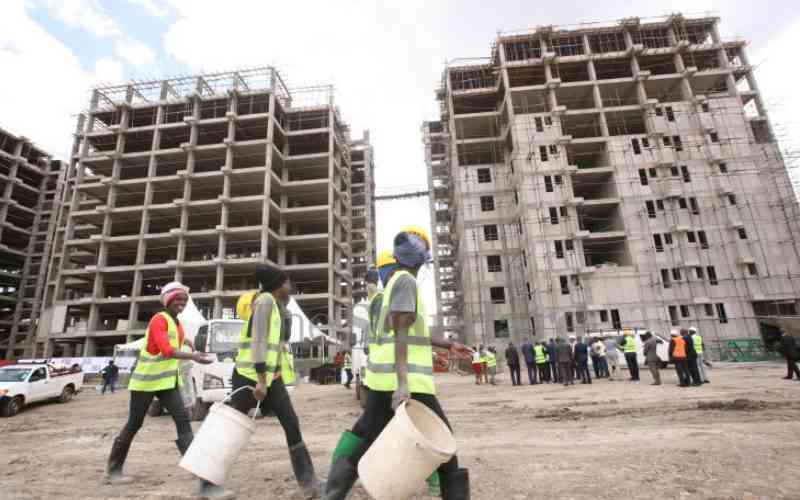According to the 2019 Kenya Population and Housing Census, more than six million people sleep and wake up in our three main urban centres – Nairobi, Mombasa and Kisumu.
The three cities, and many others across the country, have become magnets that draw thousands of Kenyans in search for better living conditions.
Sadly, their dreams soon become nightmare. From poor housing, fragmented infrastructure to little or no sanitation, millions of urban dwellers are living on life’s edge.
This week, the 2019 edition of Legatum Prosperity Index placed Kenya at position 113 out of 167 countries.
The country scored poorly in both the living conditions and economic pillars, turning a score of 132 and 135 respectively. Since 2009, Kenya has moved up the rankings table by four places.
In addition, a study done by the World Bank over the last three years states that Kenya’s main urban centres have been unable to satisfy the basic needs of residents.
Currently, Nairobi needs 790 million litres of water against the installed capacity of 525 million litres. The little that trickles to the city is periodically rationed as the county government assures “all the city residents of reliable supply of water.”
But such basic infrastructure is missing. “Only about 18 per cent of total urban population has access to a sewer line,” states the Word Bank document titled, Kenya Urbanisation Review. “70 per cent rely on septic tanks and pit latrines and the rest have access to no sanitation services at all.”
The fact that an estate like Karen, one of Kenya’s high-end suburbs is not connected to the city sewer line only points to a deep underlying problem.
But if water and sanitation have sunk Kenya’s urban dwellers into a hygienic quagmire, there is little to write home about the state of housing.
“Majority of urban dwellers live in shacks that remove all dignity from a human being. Even our secondary towns are nothing more than continuous slums that lack proper housing and other basic amenities,” says Professor Alfred Omenya, an environmental architect.
The housing statistics are not inspiring either. Every year, the housing deficit tops at 200,000 against an input of 50,000 homes, mainly in the middle to high-end segments of the market. The lower segment is left to scramble for about a thousand homes.
Even for those with some savings, the World Bank says, there is little property one can buy in Nairobi for Sh4 million. Market dynamics have conspired to push the vulnerable out of the housing bracket.
Speculative property market
“Much of the formal property market is speculative, with 75 per cent of apartment buyers doing so to rent the apartments and 16 per cent purchasing to ‘flip’ them,” says the report.
Stay informed. Subscribe to our newsletter
Paradoxically, the ongoing infrastructure upgrade being witnessed means the price of hitherto affordable land escalates as the projects open up these areas. Urban planning experts say the poor always pay the price for this development.
Many occupy land with no ownership documents. They cannot develop or use such land as collateral. “Remove these people from these areas and the land becomes prime. However, such ones cannot move out since they live close to workplaces they can access by walking on a daily basis. Their low incomes cannot support house rents in their preferred locations,” says Abraham Samoei, president of the Institution of Surveyors of Kenya.
Omenya says the degrading lifestyle of urban residents boils down to poor or no implementation of urban and spatial plans. He says allocation of funds for urban infrastructure is political and those in power will give little heed to “intangible” infrastructure projects.
“Planning has heavy political overtones. County chiefs are more interested in projects that further their political interests. Boda boda sheds with their names inscribed on top make more sense than a sewer line buried underground,” he says. In any case, Omenya argues, our counties have turned to external donors to fund basic urban infrastructure while there is money to suit their fancy.
“Why put such matters in our constitution when we cannot even afford to fund the formulation of an urban plan? Sanitation is so basic that we should fund it from our pockets,” says Omenya.
[email protected]
 The Standard Group Plc is a
multi-media organization with investments in media platforms spanning newspaper
print operations, television, radio broadcasting, digital and online services. The
Standard Group is recognized as a leading multi-media house in Kenya with a key
influence in matters of national and international interest.
The Standard Group Plc is a
multi-media organization with investments in media platforms spanning newspaper
print operations, television, radio broadcasting, digital and online services. The
Standard Group is recognized as a leading multi-media house in Kenya with a key
influence in matters of national and international interest.
 The Standard Group Plc is a
multi-media organization with investments in media platforms spanning newspaper
print operations, television, radio broadcasting, digital and online services. The
Standard Group is recognized as a leading multi-media house in Kenya with a key
influence in matters of national and international interest.
The Standard Group Plc is a
multi-media organization with investments in media platforms spanning newspaper
print operations, television, radio broadcasting, digital and online services. The
Standard Group is recognized as a leading multi-media house in Kenya with a key
influence in matters of national and international interest.









